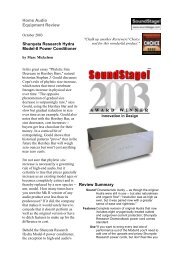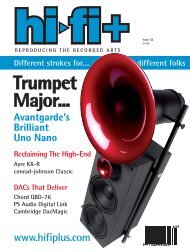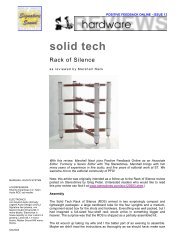Absolute Analog - Audio Note Singapore
Absolute Analog - Audio Note Singapore
Absolute Analog - Audio Note Singapore
Create successful ePaper yourself
Turn your PDF publications into a flip-book with our unique Google optimized e-Paper software.
<strong>Absolute</strong> <strong>Analog</strong><br />
The best moving coil yet?<br />
Air Tight PC-1 Cartridge<br />
Jonathan Valin<br />
Like most vinylphiles, I’ve listened to<br />
a lot of fine moving-coil cartridges<br />
over the years. The Air Tight PC-<br />
1, TAS’ 2006 Phono Cartridge of the<br />
Year award-winner, is, IMO, the best yet<br />
in nearly every aspect of phonographic<br />
reproduction—the most complete.<br />
I am scarcely alone in my admiration<br />
for the PC-1, which has been a big<br />
success critically and commercially. This<br />
is not one of those products that hides<br />
its light under a bushel. All you have to<br />
do is listen to a violin recording, like,<br />
say, Joseph Silverstein playing Bartók’s<br />
great (and greatly difficult) Sonata for<br />
Solo Violin [Columbia], and it quickly<br />
becomes obvious that you are getting<br />
40 August 2007 The <strong>Absolute</strong> Sound<br />
more information with less distortion and<br />
greater speed than you’re used to hearing<br />
from an mc.<br />
In the third movement “Melodia,” for<br />
instance, when Silverstein plays those<br />
tricky high harmonics, you not only hear<br />
how these wispy little curlicue-notes<br />
sound; you hear how they are sounded. You<br />
hear, beneath the harmonics, the faint<br />
silken rush of the bow and the shift of<br />
fingertips lightly touching strings. This is<br />
extraordinary low-level detail, bespeaking<br />
a very low noise floor and very high<br />
resolution.<br />
But the PC-1 isn’t just very quiet<br />
and highly detailed; it’s unusually fast. I<br />
thought the London Reference was a<br />
world-beater when it came to transient<br />
response; but the PC-1 audibly bested it.<br />
Just listen to any of the pizzicatos in this<br />
same movement of the Bartók Sonata<br />
to hear a new benchmark in the lifelike<br />
reproduction of plucked strings.<br />
In addition to its world-class distortion,<br />
resolution, and speed, the PC-1 is also<br />
extremely natural in timbre for a moving<br />
coil. Once again, listen to Silverstein’s<br />
violin on the double- and triple-stopped<br />
chords and trills of the “Melodia.” With<br />
their rising treble response, moving coils<br />
tend to brighten up or thin out timbres in<br />
the upper mids and highs. Not here. (At<br />
least, not when the cartridge is properly<br />
loaded to 100–500 ohms.)
<strong>Absolute</strong> <strong>Analog</strong><br />
The PC-1 isn’t just a wonderment in<br />
the treble. Its bass is just as remarkable—<br />
and in the same ways. On something<br />
like Robert Helps’ Steinway on Arthur<br />
Berger’s Two Episodes (from New Music<br />
for the Piano [CRI), you not only get the<br />
fullness of timbre of the big pedaled<br />
chords; you get the full energy with which<br />
Helps sounds them, the power with<br />
which they are projected and sustained.<br />
Many moving-coil cartridges (many<br />
stereo systems, for that matter) make big<br />
instruments like concert grands sound<br />
as if they’re getting smaller in volume,<br />
power, and projection as they descend<br />
in frequency, as if their sound is being<br />
funneled to a point, like a “V.” The PC-1<br />
reproduces deep sustained notes as they<br />
sound in life—expansive, bottomless, and<br />
open, like an upside-down “V.”<br />
Happily, the PC-1 is also exceptional<br />
in the midband, reproducing voices from<br />
John Shirley-Quirk’s resonant baritone<br />
on Lutoslawski’s haunting Les Espaces<br />
du sommeil [Columbia] to Joan Baez’s<br />
gorgeous soprano on “Gospel Ship”<br />
(from Live in Concert [Cisco]) with in-theroom-with-you<br />
presence, while, at the<br />
same time, fully reproducing the acoustic<br />
of the hall each singer is singing in.<br />
The PC-1’s truly extraordinary<br />
resolution of timbre, dynamics, and<br />
detail is no accident. As I noted in my<br />
Kuzma vs. Walker review in Issue 171,<br />
the cartridge is the end product of many<br />
years of research. Designed by the late Y.<br />
Matsudaira, who was largely responsible<br />
for some of the legendary coils from<br />
Koetsu and Miyabi, the PC-1 uses a<br />
new high-µ core and winding material<br />
(designated SH-µX) that is said to have<br />
three times the saturation flux-density<br />
Truly<br />
extraordinary<br />
resolution<br />
and initial permeability of conventional<br />
core materials. In plain English, the PC-<br />
1’s magnets produce a much stronger<br />
magnetic field, greatly lowering noise<br />
and coloration and greatly increasing<br />
resolution in every regard. Details are<br />
clearer, timbres are truer, air is more<br />
plentiful, dynamics are more lifelike,<br />
and stage width, depth, and height are<br />
expanded.<br />
As I said in Issue 170, the PC-1 isn’t<br />
simply a slight improvement over what came<br />
before it; it is a leap forward in moving-coil<br />
design. And well worth its $5500 asking<br />
price. (A superb tracker, the PC-1 fares best<br />
between 2.03 to 2.11 grams.) TAS<br />
Specs &<br />
Pricing<br />
Output: 0.6 mV at 1kHz 5cm/sec<br />
Stylus: 3µm x 30µm semi-line contact<br />
Tracking force: 2.0 to 2.2 grams<br />
Weight: 11 grams<br />
Price: $5495<br />
Axiss <strong>Audio</strong><br />
17800 South Main Street, Suite 109<br />
Gardena, CA 90248<br />
(310) 329-0187<br />
axissaudio.com<br />
42 August 2007 The <strong>Absolute</strong> Sound



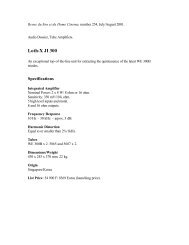
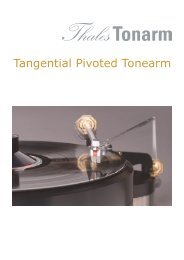
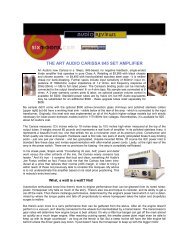
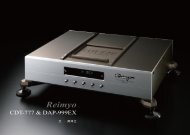

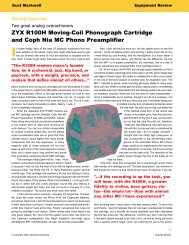
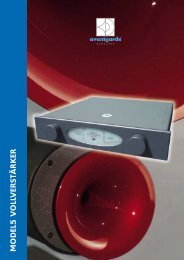
![DAP-999 EX Limited [pdf] - Audio Note Singapore](https://img.yumpu.com/27191044/1/190x253/dap-999-ex-limited-pdf-audio-note-singapore.jpg?quality=85)
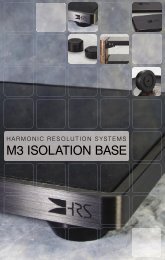
![Harmonix CS-120 Improved-Version [pdf]](https://img.yumpu.com/24411255/1/184x260/harmonix-cs-120-improved-version-pdf.jpg?quality=85)
